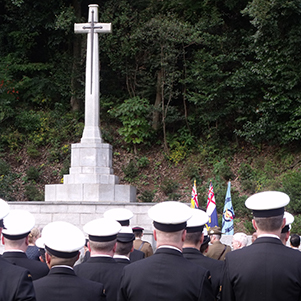A poignant tribute to a fallen British soldier
- Embassies, schools and organisations pay their respects in Yokohama
- Event attendees mark 100th anniversary of the start of World War I
- Single plot in Yokohama for war’s solitary British veteran
Commonwealth embassies, schools, associations and organisations gathered to pay their respects at the Commonwealth War Cemetery in the Hodogaya district of Yokohama.
The only annual Remembrance Day ceremony in Japan was held on 9 November, the closest Sunday to the 11th hour of the 11th day of the 11th month, when the guns on the Western Front finally fell silent.
While the vast majority of the graves are for men from the UK, Australia, New Zealand, Canada and India who died during World War II, there is a single plot for a British veteran of World War I.
Initially a trumpeter with the Honourable Artillery Company—the second-oldest military organisation in the world—Sir Cecil “Boy” Bouchier KBE CB DFC became a flying officer with the Royal Flying Corps in February 1918.
He was awarded the Distinguished Flying Cross the following year, the citation of which described him as “a very skilful pilot of marked initiative and courage”. It added that his “methods are somewhat original”.
A squadron leader with the Royal Air Force, Bouchier was named commanding officer of the Indian Air Force, and was awarded an OBE before the outbreak of World War II, and in 1953 received a KBE.
He commanded an RAF station during the Battle of Britain in 1940, and was subsequently promoted to the position of air officer commanding with the British Commonwealth Occupation Force in Japan in 1946.
Eventually rising to the rank of air vice-marshal, Bouchier died in 1979. Today, his plot has a simple black plaque atop a low, whitewashed plinth.
He was laid to rest alongside the graves of men from the second global conflict, victims of the Korean War in the early 1950s, as well as service personnel of the occupation forces and their families.
In front of Bouchier’s grave is a wreath of poppies presented by his widow, Lady Bouchier MBE.
The scarlet poppies laid in front of graves throughout the cemetery and represented in the lapels of those paying their respects were in contrast to the russets and gold of the carefully tended parkland that was first created by an Australian War Graves Unit in 1945.
“The Commonwealth has put on a good show again and it always strikes me just how beautiful and peaceful this place is”, said Arthur Hawtin, chairman of the Tokyo branch of the Royal British Legion.
“There are certainly more people here than in previous years and I think that is very probably because of the commemoration of the start of World War I”, he added.
“There has been a lot of publicity about the centenary in Europe, such as the public’s response to the display of hundreds of thousands of poppies in the moat at the Tower of London”.
The Embassy of Canada presided over this year’s Remembrance Day event in Yokohama, with representatives of the Roman Catholic, Anglican, Hindu, Jewish and Buddhist faiths each delivering commemorative observances.
Captain Chris Dickinson of the Royal Canadian Navy read the moving poem In Flanders Fields, written during WW I by the Canadian doctor Lieutenant Colonel John McCrae.
Ambassador of Canada to Japan Mackenzie Clugston then read The Exhortation, the four immortal lines that conclude with “We will remember them”.
The wreath of poppies from the British Chamber of Commerce in Japan was laid by David Bickle, president.
“It’s a very poignant place and event, particularly because this is the 100th anniversary of the start of the First World War”, Bickle told BCCJ ACUMEN. “It’s obviously very important that the British community is represented here, and not just this year, but every year.
“It’s important that we remember their sacrifices and the sacrifices that are still being made today. Just walking around reading some of the inscriptions on the stones—and looking at their ages—is very poignant”, he added.
Some of the most moving have no names.
In the middle of a line of a dozen marked plots is one that reads, simply, “A soldier of the 1939–1945 war, 21st October 1942. Known Unto God”.




